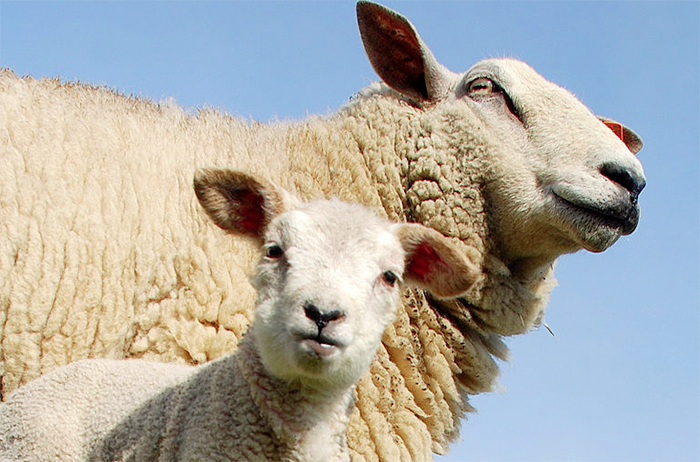
New government figures have revealed the Schmallenberg virus has spread to more than 1,500 farms in the UK with the disease moving progressively northwards. The virus has been reported in all counties of England, Wales and Northern Ireland and may begin to circulate in Scotland this year.
The disease, which leads to lambs and calves being stillborn or deformed, led to widespread worry in the early lambing season with figures indicating up to a 60% loss being suffered by early flocks. Farmers began to complain over the lack of information released by Defra but the Animal Health and Veterinary Laboratories Agency newly reported over 1,531 infected farms, a 26% increase from January figures.
Spread by midges, the virus was first identified on German and Dutch farms in 2011 and spread throughout parts of Europe and southern England. Results from surveillance across GB in 2012 indicated much wider evidence of spread of SBV and sero-positive animals have been found in the North of England.
Leicestershire sheep farmer and NFU livestock board chairman Charles Sercombe saw Schmallenberg early in his own flock. He said concern was growing in the industry and highlighted a need for a vaccine to combat the virus.
"Any infection present on farm now will have taken place last year and there is nothing that can be done to alleviate issues at the moment. But it is important that a vaccine is made available this year to give our sheep farmers the choice of whether to vaccinate their flocks against this disease." he said.
Recently, the Veterinary Medicines Directorate said it was considering an application by MSD Animal Health for its virus vaccine Bovilis SBV. Though the date of its commercial release is unknown, the executive agency of the Department for Environment, Food and Rural Affairs (Defra) said MSD submitted the application at the end of August.
Dr. Rene Aerts, vice president Global Biologicals R&D Animal Health said: "Using our experience gained a few years ago during the fast-track development of the first vaccine against bluetongue 8 virus in just 21 months, we are now on track to develop a vaccine against Schmallenberg virus in an even shorter time."
"After we isolated the virus last December, we have diligently worked in an integrated and interdisciplinary team at BioSciences Center Boxmeer and our manufacturing site in Burgwedel to develop this vaccine. We anticipate, pending regulatory approvals, to have a vaccine available for our customers by the end of this year."
NFU Scotland President Nigel Miller said: "SBV is not a notifiable disease but experience in England and other parts of Europe has shown the devastating impact the disease can have on lambs and calves. It is of such importance to our members that we will co-ordinate the testing effort and fund the laboratory work and will be working with SRUC and Biobest Laboratories to circulate the results."
"It is hoped that vaccination will be an option in 2013. However, management changes – such as delaying the introduction of bulls and rams – can also minimise the impact of the disease on calves and lambs" he added.
The results of several studies were presented at a symposium on the virus during the 6th Annual Meeting of EPIZONE (an international network of veterinary research institutes working on epizootic animal diseases), which took place in Brighton in last June.
The vaccine is based on wild-type Schmallenberg virus that has been inactivated and contains an adjuvant that stimulates the immune response.
While not particularly worrying in adult animals, the clinical signs in foetuses infected during gestation are, however, alarming: abortion, hydrocephalus, muscular atrophy. A team from the University of Liège’s Pathology Laboratory is closely monitoring this new epidemic.
"The symptoms observed in adult animals aren't very specific and only last about a week" said Mutien-Marie Garigliany, doctor in veterinary medicine and research assistant at ULg's Pathology Laboratory, led by Professor Daniel Desmecht.
"On the other hand, this new pathogen can cause abortions and serious malformations, especially in the nervous system of young animals infected during gestation." Researchers at the Friedrich Loeffler Institute (FLI), the main federal German research organisation for animal health, were therefore quick to begin looking for the causes of the epidemic.
Livestock representatives from the main UK farming groups met in London in February to discuss on-going challenges facing the sheep industry both past and present. The summit was called following what many considered was a challenging year for producers with the main problems being weather, longer finishing periods, disease challenges, rising costs and a marked drop in lamb prices over the past year.
A joint industry statement said: "Confidence in the sheep sector is at rock bottom. Factors such as the weather, rising costs and disease are contributing to make the ‘perfect storm’ and farmers are being left to produce lamb at less than the cost of production. All four UK unions have committed to pull together to address the challenge farmers in countries across the EU are facing from cheap New Zealand imports and pressure on farm margins."
"We believe there is scope to review Specified Risk Material (SRM) controls which devalue older lambs and we would also urge the UK processing sector to take more of a lead to improve transparency for producers in the deadweight lamb market."
"Despite the troubling times, we believe there are grounds for optimism in the long term. We know our lamb is in demand both at home and abroad but the industry must regain its confidence to invest in the future if we are to exploit these opportunities."
